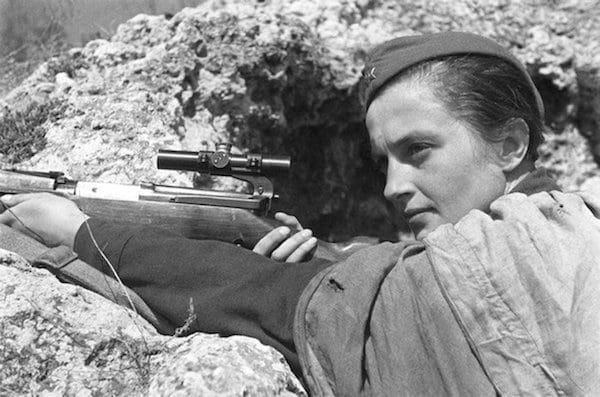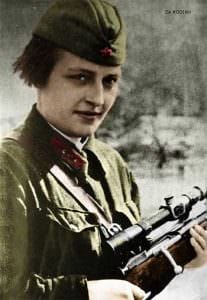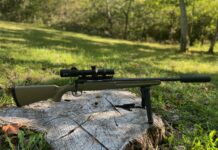
John Farnam writes [via ammoland.com]:
The American Revolutionary War pitted Colonial frontiersmen against British Regulars. “Regulars” in all armies of the day were issued smooth-bore muskets. Projectiles were round balls, not very accurate (at least by today’s standards), but reloading was much faster than was the case with rifles.
Period infantry tactics dictated that individual initiative on the part of infantryman was never allowed. You fired muskets only in volleys, and only when directed. Your target was not an individual enemy soldier, but rather a “rank” of soldiers, and ranges were short, always less than fifty meters. Muskets were “leveled,” not “aimed.” Such volleys, sometimes several in number, where followed by bayonet charges, because reloading could often not be accomplished before the enemy closed the distance and was upon you.
This mantra was pretty standard for European land battles, which had been more-or-less continuous since Roman times. Europeans got lots of practice.

However in the American Colonies, farmers and frontiersmen were accustomed to owning and shooting rifles, not military-style muskets. Both were muzzle-loading, but the rifle bullet had to literally “pounded” down the bore as it engaged the rifling, so reloading was slow (which is why infantry commanders didn’t like them).
Muskets were relatively inexpensive and easy to manufacture, while rifles were the product of a fellowship of skilled artisans. They were highly “individual,” slow to manufacture, and expensive. But rifles, in the hands of capable marksmen, were accurate enough to hit individual human targets at 200m, sometimes as far as 500m, while muskets were hopelessly inaccurate after 100m.
So, for hunting and general use, rifles were preferred by Americans.
The stage was set!
At the beginning of the American Revolution, smart money was on the British. In fact, during the entire conflict there were precious few genuinely decisive battles, save Yorktown, where the War finally ended (only to reignite during the War of 1812).
Washington and his American citizen/soldiers wore-down the British, using conventional tactics, but introducing a new one, with which the British were not prepared to deal effectively, and during the entire course of the War, never did.
American sharpshooters, employing their own initiative and judgement, roamed independently over the battlefield with their rifles and picked-off individual British officers and NCOs. The tactic was often so effective that entire British regiments were effectively rendered leaderless, sometimes within minutes.
Of course, the British considered all this inherently dishonorable, and these first “snipers” to be war criminals, not soldiers. However, they had no solution to this “problem,” and were too proud to develop one. This new tactic, combined with classic British arrogance, sealed their fate.

Within a few decades, the French conical “Minie Ball” solved the slow-reloading issue with rifles, and by the time of the American Civil War, smooth-bore muskets had thus been mostly replaced with rifles. They were still muzzle-loading, but flint-locks were now gone, replaced with the much less distracting cap-lock.
Now, any enemy combatant closer than 500m, in some cases even further, was in grave danger.
Sadly, most military leaders were naively training and gearing-up, as they always do, to fight the last war, so individual marksmanship training and tactics lagged far behind these fast-moving technological developments, but some innovative and visionary Operators, who were also expert marksmen, saw the potential, and were not about to wait around for the rest of the world to catch up.

Sir Joseph Whitworth, a well-known and prominent British engineer and manufacturer, produced his famous “Whitworth Rifle,” expensive, but superior to nearly every other military rifle of the era. Despite spectacular demonstrations, Whitworth enjoyed scant success in interesting his own government in his wares. But, the Confederate Army on the American Continent took keen notice, and purchased a number of them.
If fact, Whitowrth Rifles quickly became status symbols within Confederate units, and the best marksmen naturally gravitated to them. Most Confederate soldiers were farmers and frontiersmen, who knew fieldcraft, were expert marksmen, and were fully capable of appreciating this wonderful weapon and what it could do. The industrialized north could not recruit nearly so many.
These Confederate sharpshooters, still not called “snipers,” quickly demonstrated their worth in effectively eliminating leadership of opposing Union units, in short order. This tactic, used so efficaciously during the Revolutionary War (an noted above), subsequently lost on the Federal Army (at least in the beginning), was now being used with devastating effect by Confederates. Confederate commanders thus allowed (reluctantly at first) their sharpshooters much leeway in deploying themselves and determining best locations to set up.
South African Dutch (Boers) were to show themselves equally effective, and for the exact same reason, during the Anglo-Boer War at the end of the Nineteenth Century.
The aforementioned “cultural lag” proved the undoing of highly-respected Union General John Sedgwick during the Battle of Spotsylvania (VA) on 9 May 1864.
During this Battle, several Confederate sharpshooters fired upon Sedgwik’s entourage from a great distance. Some of Sedgwick’s subordinates quickly got down and went to cover. Sedgwick was annoyed, considering himself and his party well out of range of enemy rifle fire.
He scolded them, with: “They couldn’t hit elephants at this distance…”
Just as he completed his sentence, a bullet struck him under his left eye. He instantly collapsed, dying within seconds. His precipitous death was devastating to the Union Army, and to General US Grant personally.
Decades after the War ended, at least five (now aging) Confederate sharpshooters claimed credit for the fatal shot. There is little doubt that it came from a Wentworth rifle.
Sergeant Charles D Grace, of Company B, 4th Georgia Infantry, is the one most likely to have delivered the shot in question, but that is by no means certain. In any event, Sgt Grace did have an iron-sighted, 451 caliber, Wentworth rifle. If it was Grace who made the fatal shot, range was in excess of 500m.

“Snipers,” (the term comes from the Nineteenth Century practice of using rifles to shoot small birds, snipe, at long distances) always a dashing, cliquish group, were from the Civil War forward, the “bastard stepchildren” of Western armies.
Sniper units were thus always the first to be disbanded at the end of every war, only to be frantically reconstituted, retrained, and re-equipped at the beginning of the next.
During WWII, the potency of snipers was not lost on Russians, who themselves learned this bitter lesson fighting savvy Fins during the Winter War of 1939. Russians subsequently trained and equipped thousands of snipers, including many women. (Learn the story of Lyudmila Pavlichenko) Russian snipers effectively paralyzed an entire German army at Stalingrad in 1942/43.
The thought of an individual with a capability, upon his own summary command and judgement, to strike a precise and deadly blow, from an invisible position, at long distances, has always been uncomfortable, even frightening, to military commanders and politicians alike, and always will be.
All self-respecting Operators are competent marksmen, “sharpshooters,” if you will. Snipers take it to the next level!
/John
—————————
About John Farnam & Defense Training International, Inc
As a defensive weapons and tactics instructor John Farnam will urge you, based on your own beliefs, to make up your mind in advance as to what you would do when faced with an imminent and unlawful lethal threat. You should, of course, also decide what preparations you should make in advance, if any. Defense Training International wants to make sure that their students fully understand the physical, legal, psychological, and societal consequences of their actions or inactions.
It is our duty to make you aware of certain unpleasant physical realities intrinsic to the Planet Earth. Mr Farnam is happy to be your counselor and advisor. Visit: www.defense-training.com




Having once competed with a Flintlock Rifle in competition with a modicum of proficiency, I never had to ‘pound’ a patched ball down the bore. A well lubed patch, and a decent amount of a low melt temp lube applied before loading, helped defeat even the famed black powder fouling.
Swabbing the bore every 10 shots or so also defeated said fouling. Not difficult, nor time consuming.
But did you actually engage the rifling? You and drop in a smaller diameter round even in a musket to speed loading. but accuracy and velocity suffers.
Yeah, there is a whole lot wrong with Mr. Farnham’s article, both historically and technically.
The first is the suggestion that rifles were in use by most of the American irregulars. Because of many of the reasons Mr. Farnham listed, rifles were more rare than smoothbore “rifles” and fowlers. Even among the colonists, they likely represented less than 30% of the arms used.
The line about hitting anything past 100 yards with a musket being “hopeless ” is badly misinformed. A Brown Bess, as used on both sides, could be expected to put a ball in an 8″ circle from that range. I have done this myself. I shoot in flintlock matches and I’ve watches plenty of people hit a 10″ cirlce with the Brown Bess at 100 yards, and that’s standing off-hand.
As you stated, if you are really pounding a ball down, you are doing it wrong. A musket is 30% faster to reload than a rifle, but that’s it. He also doesn’t even mention buck and ball and it’s use in infantry tactics, or the British use of sharp shooters, which began long before the revolution. French-Indian War ring a bell at all here? Or where these rifles came from in the first place, that is, the German Jaeger rifles, in existance for many decades before the revolution.
There’s really too much wrong to go into all of it.
It’s almost as though Mr. Farnham likes to do whatever he can to get his name in print and someone was happy to oblige him.
I would point out a couple things here jwt:
A match vs. old school line up, stand in place/kneel, follow orders and hope you don’t get hit by those guys standing over there when they fire a volley battles are completely different.
The question isn’t really “What is the weapon capable of?” but rather “What is the average user capable of when the lead is flying and people all around them are getting shot?”.
I’m no expert, but I imagine simply standing in a line shooting at each other this way is shit-your-pants scary which means accuracy will often go out the window and reloading times will likely stretch. Today we talk about people who miss the mag well under stress where all they really need to do is slap in a mag and let the slide/BCG go forward. What happens when you add a bunch of steps to that process before you can fire again? Well, if nothing else the potential for many more mistakes is introduced.
After the battle of Gettysburg, in some cases for many years afterwords, people found ram rods stuck into trees on the Round Tops. Each one clear evidence that under stress someone got partway through the full reloading process with their rifle and fired it before removing the rod.
Again, I’m no expert on 1800’s weaponry or combat but it strikes me that the faster and easier to use you can make the gun the better it is for that type of combat. I would also imagine that many people back then suffered from eye issues that today we correct with glasses or contacts and therefore a mild astigmatism or mild near sited issues would make accurate shooting at 100 yards nearly impossible. You’d just aim for the rank of people and fire, hoping to hit someone.
The counter argument would be that in those days, there were not the visual distractions that occur today, eg the internet, video games, even reading. All of these activities take a toll on long distance vision. Days spent looking after livestock and other energetic agricultural pursuits help increase overall blood flow and visual acuity. So the net effect would be about equal for weapons sighting ability. Maybe they put the half blind recruits in the rear rank?
“After the battle of Gettysburg, in some cases for many years afterwords, people found ram rods stuck into trees on the Round Tops.”
That makes sense, I recall years back hearing about an inventory of Gettysburg battlefield rifles the days after the battle showed a sizable percentage were loaded wrong, as in a patch and ball, with no powder, or ‘stacked’ complete loads (2+ balls-minis and powder on top of each other).
Add in the likely terror of flying lead and seeing your buddies getting mowed down…
I was told that the sharpshooter tactic was learned from the American Indians. They utilized the tactic because it worked so well against them.
That’s much closer to the real history, and how the American Longrifle was developed. Read up on the French Indian war and Robert’s Rangers.
I believe you meant “Rogers’ Rangers” under the command of Robert Rogers, yes?
Guerilla “hit and run” warfare was yet another tactic utilized by the colonists that was gleaned from the reds. In many ways the US owes its native populace a debt that cannot be repaid, not just in early wars, but in all.
History has shown that many of its most adept snipers, were little more than country bumpkins, with a quick wit and adroitness in hunting and survival. This bland outwardness that obscures such an inherently lethal proficiency of such individuals, makes for quite the fascinating specimens. The lack of a specific mention of Simo Häyhä is disappointing.
Little guy. Name I’m never sure I’m saying right and humbly apologise if I’ve said it wrong. Didn’t use a scope on his Mosin. Also used a sub gun with great skill and courage.
The White Death. Nothing but respect for him.
“(Learn the story of Lyudmila Pavlichenko)”
That link is well worth the read:
http://www.businessinsider.com/lyudmila-pavlichenko-female-sniper
There was a Russian movie about her exploits in 2015:
Battle for Sevastopol (2015)
…and it appears there’s an 850.48 MiB copy of it floating around out there with English subs. *cough*…
The preview looks really good.
https://www.youtube.com/watch?v=VzCOFER-4hI
Woefully inaccurate and written at about a 6th grade level?
If it had more hyperbolic exaggeration and dog-whistle racism, I’d swear it was an article by Boch.
Yeah there have been female snipers but look at how many are depicted here vs. how many in real life respective to how many men have been snipers. Title IX much?
In all the talks of great snipers rarely do you here about “the greatest”:
Simo Häyhä
https://en.wikipedia.org/wiki/Simo_H%C3%A4yh%C3%A4
He was one of the Finns that gave the Soviets “trouble”.
Geez. So much wrong in this article.
You mean like the fact that the Whitworth rifle changed, after its first four mentions, to a Wentworth rifle for the final two mentions?
Seriously. I can’t speak to historical accuracy; there are others here much more capable of that, obviously. But does nobody ever actually proofread anything anymore?
This reads about like I’d expect for an 8th grade book report.
The biggest reason the Colonists killed so many of the British troops was how they used their muskets prior to the battle. These were subsistence farmers and hunters; if you missed the deer, your family could go hungry, so you took careful aim. The British regulars were only trained in volley fire and most of them closed both eyes and yanked the trigger, clearly not the recipe for accurate aimed fire!
Not on-topic I know, but reflecting on the American Revolution, such divergent paths our two countries took from then until now. The U.S, still with many sharp-eyed shooters of all varieties , hunters to competition shooters,
Britain, shunned firearms use and ownership and begged for donated weapons even in WW2 from us to arm the homeland. Yes, I know that small groups still take part in “hunts” there. Am I glad to be born free!
A lot of flaws! Here’s another: Yorktown certainly was decisive in that it was the final straw that convinced George III to give up the war and agree to independence. But ignoring Saratoga is ludicrous. It convinced the British to give up on their northern strategy, and it convinced the French that aiding the colonies had some potential as a means of separating Britain from North America and regaining some kind of foothold after losing Quebec. And from a historical perspective, it also showed how inept British upper management was, how jealous all its commanders were of each other, how ill-prepared they were for a war 3000 miles away, and how they refused to recognize any such faults and kept on keeping on until Yorktown showed it again.
It’s especially interesting in that irregulars with precision rifles were a major factor in the win, which I would have expected to matter for the rest of the theme.
There is plenty of historical records to show that muskets could be pretty damn accurate at reasonable ranges and that the infantry practiced shooting “marks” suggesting they did take individual aim in combat or were at least supposed to.
This article, like so many others, definitely over plays the influence of American riflemen in the war as many above have already pointed out. Outside a few select battles, their role was limited.
Comments are closed.